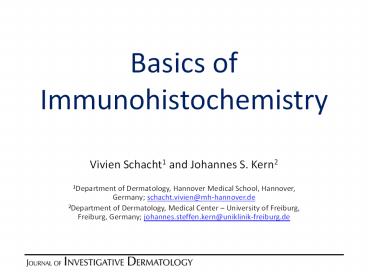Basics of Immunohistochemistry - PowerPoint PPT Presentation
1 / 8
Title:
Basics of Immunohistochemistry
Description:
Basics of Immunohistochemistry Vivien Schacht1 and Johannes S. Kern2 1Department of Dermatology, Hannover Medical School, Hannover, Germany; schacht.vivien_at_mh-hannover.de – PowerPoint PPT presentation
Number of Views:459
Avg rating:3.0/5.0
Title: Basics of Immunohistochemistry
1
Basics of Immunohistochemistry
- Vivien Schacht1 and Johannes S. Kern2
- 1Department of Dermatology, Hannover Medical
School, Hannover, Germany schacht.vivien_at_mh-hanno
ver.de - 2Department of Dermatology, Medical Center
University of Freiburg, Freiburg, Germany
johannes.steffen.kern_at_uniklinik-freiburg.de
2
INTRODUCTION
- Immunohistochemistry (IHC)
- Demonstrates specific antigens in formalin-fixed,
paraffin-embedded (FFPE) tissues. - Antigen-antibody construct is visualized through
light microscopy gt morphology of the tissue
around the specific antigen is visible. - Results are reported semiquantitatively
(0) and have important diagnostic and
prognostic implications.
3
HISTORY
- 1940 immunofluorescence staining on frozen
sections based on antigen-antibody interaction
was presented by Coons. - 1974 Taylor and Burns developed IHC on routinely
processed FFPE tissues. - 1975 Köhler and Milstein presented the hybridoma
technique to produce monoclonal antibodies. - gt broad range of antigens and high staining
quality
4
How Is Immunohistochemistry Performed?
- Tissue processing and epitope retrieval Formalin
fixation Cutting sections Mount on glass
slides Enzyme digestion - Antigen-antibody interaction Direct or indirect
method - Visualization through different detection
systems Fluorescent compounds or active enzymes
5
Quality Control
- Purpose Sensitive and specific, reproducible
and standardized - Positive control Sample containing the antigen
of interest - Negative control Same sample as for the
positive control, but primary antibody replaced
by non-binding immunoglobulin - Validation of IHC Round robin tests Staining
various tissue and tumor types Comparing
staining results of different antibodies that
recognize similar proteins.
6
Immunohistochemical Techniques
7
(No Transcript)
8
Immunohistochemical Results for Select BRAF
V600E Mutation Positive Cases by DNA Analyses
Feller et al. 2013

